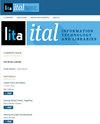数字遗产藏品的知识图谱可视化界面
IF 1.5
4区 管理学
Q3 COMPUTER SCIENCE, INFORMATION SYSTEMS
引用次数: 0
摘要
数字遗产门户网站的界面一般与数字图书馆和搜索引擎的界面相似,都是以简要元数 据记录列表的形式显示搜索结果。这些系统的知识组织和搜索结果显示都是以条目为中心,很少支持识别条目之间的关系。本文提出了一种知识图谱系统和可视化界面,作为数字遗产系统的一种有前途的解决方 案,以支持用户浏览相关条目,了解条目之间的关系,并综合叙述一个问题。本文讨论了知识图谱、图谱数据库和图谱可视化的设计问题,并根据作者为档案和数字人文资源开发三个知识图谱系统的经验提出了建议:新加坡南洋艺术学院的祖比尔-赛义德(Zubir Said)个人档案收藏;新加坡先锋社交网络;以及亚洲传统草药知识图谱。从一项小型用户研究中汲取的经验教训也纳入了讨论。本文章由计算机程序翻译,如有差异,请以英文原文为准。
Knowledge Graph Visualization Interface for Digital Heritage Collections
Digital heritage portal interfaces are generally similar to digital library and search engine interfaces in displaying search results as a list of brief metadata records. The knowledge organization and search result display of these systems are item-centric, with little support for identifying relationships between items. This paper proposes a knowledge graph system and visualization interface as a promising solution for digital heritage systems to support users in browsing related items, understanding the relationships between items, and synthesizing a narrative on an issue. The paper discusses design issues for the knowledge graph, graph database, and graph visualization, and offers recommendations based on the authors’ experience in developing three knowledge graph systems for archive and digital humanities resources: the Zubir Said personal archive collection at the Nanyang Academy of Fine Arts, Singapore; Singapore Pioneers social network; and Polyglot Medicine knowledge graph of Asian traditional and herbal medicine. Lessons learned from a small user study are incorporated in the discussion.
求助全文
通过发布文献求助,成功后即可免费获取论文全文。
去求助
来源期刊

Information Technology and Libraries
管理科学-计算机:信息系统
CiteScore
2.90
自引率
5.60%
发文量
25
审稿时长
1 months
期刊介绍:
Information Technology and Libraries publishes original material related to all aspects of information technology in all types of libraries. Topic areas include, but are not limited to, library automation, digital libraries, metadata, identity management, distributed systems and networks, computer security, intellectual property rights, technical standards, geographic information systems, desktop applications, information discovery tools, web-scale library services, cloud computing, digital preservation, data curation, virtualization, search-engine optimization, emerging technologies, social networking, open data, the semantic web, mobile services and applications, usability, universal access to technology, library consortia, vendor relations, and digital humanities.
 求助内容:
求助内容: 应助结果提醒方式:
应助结果提醒方式:


